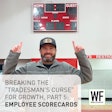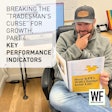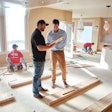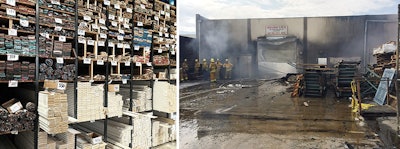
A fire completely destroyed my wood flooring wholesale and supply warehouse, and all the inventory within, in September 2015. Although we were relatively well-prepared, I wish someone had told me before it happened what it would be like; it would have helped me navigate the rebuilding process. I hope my experiences can help others who might have to go through a disaster in their business.
I learned about the warehouse fire at my company in Los Angeles while I was in Israel. My wife called me around 4 a.m. her time, 2 p.m. my time. The news couldn't have come at a worse time. I was tending to my mother, who was ill and close to passing.
My business, National Hardwood Flooring and Moulding, had been my life since I established it in 1984. I'd built it from nothing to one of Los Angeles' premier wholesale hardwood and supply warehouses, with millions in annual revenue. The warehouse had more than a million square feet of hardwood flooring at the time of the fire in September 2015. Half a million dollars in product was already spoken for and scheduled to be shipped. It all went up, and the flames persisted for four days. When the embers cooled, an empty, desolate skeleton was all that remained. All our inventory was now ashes.
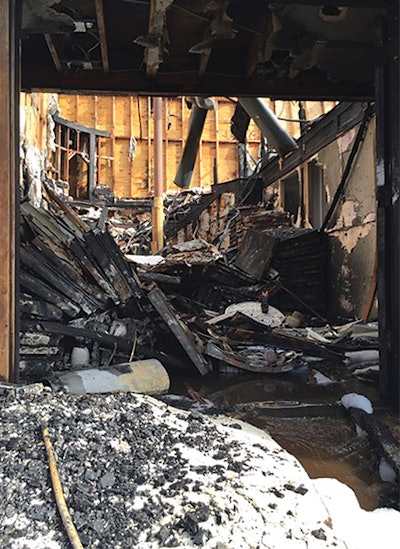


I called my employees on a conference call to touch base. Nobody was hurt. They had all left their homes in the middle of the night to go to the warehouse while it burned to see if they could help. They feared we would lose our customers, and everybody was worried they might lose their jobs.
We could have simply declared bankruptcy and walked away, but I couldn't stomach the thought of letting our longstanding customers and our employees down. I told my employees that if we built this company from nothing before, we could do it again. We just needed to stay strong.
The first order of business was to call all our customers and vendors and explain what had happened. I thought using humor would help them sympathize with our situation, so I would start our calls by telling them, "Why didn't you come to the BBQ party? It was huge. It lasted five days!"
It's a beautiful thing in this industry that when disaster strikes, people come together and make it their responsibility to help each other. Vendors I had built great relationships with over the years expedited material shipments to our warehouses. An overseas manufacturer of prefinished flooring typically takes 60–70 days to ship to us, but my contact was able to get me a shipment in 25 days. Our employees at our custom flooring mill took on extra shifts. Not one customer, not even those who lost pending shipments in the fire, cancelled their orders.
The insurance claim took us three weeks to put together. I handed over 8,800 pages of documents. The first insurance agent assigned to our claim told us she had never seen such immaculate records; that's all thanks to the software we use. I can tell you within a minute how much of any product we had in stock on any day of the year. All our receipts, invoices, etc., are sent to our bookkeeper and digitized, so they are also easy to access and sort through.
The model and serial numbers of all our tools, machinery and miscellaneous equipment are dutifully written down and saved until we no longer own the item. We also take photographs of the interior of our warehouse at least twice a year. This made it easy to prove to the insurance company that we had what we said we had, and also made the scale of our losses immediately and viscerally apparent.
But what good is a data system if the fire destroys all your computers (which in our case, is exactly what happened)? We were prepared for that. For years we had been making backups of all our data on a daily basis, and it was our practice to store them off-site. The data survived.
Despite our comprehensive data, the claims process was long and painful. Over the course of our claim, the insurance company replaced our main contact person eight times. It felt like every time someone was beginning to understand the complexity of our situation, they were reassigned. We began to wonder: Was the insurance company playing games with us?
Making matters worse, our insurance was set up to pay for only six months of business losses in the event of a disaster. I didn't think it could be possible for our claim to take longer than that to go through, but it did—it took a year and a half for our full claim to be paid. Eventually I had to have a lawyer send the insurance company a letter demanding business losses for at least a year plus an extra cash sum, and they agreed.
We had also rushed right away to hire a public adjuster—an independent claims handler who is supposed to support us, the policy holder, in the claims process. In hindsight, we should have simply hired a competent attorney. The public adjuster we hired was accustomed to smaller jobs—$30,000; $50,000; $70,000 claims—not claims in the millions. We felt he dragged his feet throughout the process. Our insurance broker, on the other hand, was very helpful from the get-go. He actually got us our first check, worth $500,000, within two weeks after the fire. The insurance broker doesn't get paid to help you; he wants to help you because you're his business. The public adjuster, who gets paid commission, asked our broker not to interfere anymore after that.
What we took away from this experience is two-fold. In regards to handling our customers, it was crucial to our success that we were forthright and acted quickly. My staff and I contacted our clients immediately and continually updated them on the status of their orders. This helped ease their anxiety. Regarding insurance, it would have been helpful to have a better understanding of our insurance limits and supplemental coverages. We should not have accepted a shortened period of loss, because it took us much longer to get back on our feet than I originally anticipated.
To have a business disaster and simultaneously suffer the loss of someone as important as my mother was awful. But at least when it came to the destruction of our business, we were somewhat prepared. We've slowly and meticulously built up our inventory to a tolerable level and are well underway in our struggle to return to our strong position. The burned warehouse skeleton is now an active construction site, and the building should return to service in the beginning of 2018.























